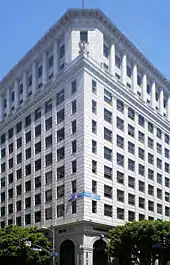7th Street (Los Angeles)
7th Street is a street in Los Angeles, California running from S. Norton Ave in Mid-Wilshire through Downtown Los Angeles. It goes all the way to the eastern city limits at Indiana Ave., and the border between Boyle Heights, Los Angeles and East Los Angeles.[1]
Originally agricultural land, 7th Street between Broadway (on which corner stood Bullock's) and Figueroa Street, became downtown's upscale shopping district. This began with J. W. Robinson's deciding to build their flagship store in 1915 on Seventh far to the west of the existing Broadway shopping district, between Hope and Grand streets. The Ville de Paris and Coulter's as well as numerous specialty shops came and rounded out the district.
The area lost its exclusivity when the upscale downtown stores opened branches in Hollywood, Mid-Wilshire, Westwood and Pasadena in the late 1920s through the 1940s, notably the establishment of Bullock's upscale landmark branch Bullocks Wilshire in Mid-Wilshire in 1929.[2]
Thirteen large office buildings opened between 1920 and 1928. By 1929, every plot on 7th between Figueroa and Los Angeles Streets had been developed.[2] The area remained an important, if not the most exclusive, center of retail and office space throughout the 1950s, but started a slow decline throughout the 1980s due to suburbanization. It was also the concentration of Downtown financial activity on Bunker Hill, a few blocks north. The flagship department stores like Bullock's (1983), Barker Brothers (1984) and Robinson's (1993) had closed and only the Broadway/Macy's at The Bloc, previously named Broadway Plaza remained. However, in 1986, the Seventh Market Place mall, now FIGat7th, opened, bringing a smaller retail cluster back to Seventh such as the 7th Street/Metro Center station opening in 1991.
With new, large skyscrapers such as the Wilshire Grand Center and the nearby U.S. Bank Tower bridging the gap with Bunker Hill, Seventh Street is now contiguous to the large financial district to the north and is once again a highly desired office district.
.jpg.webp) 1907, west along 7th from Main
1907, west along 7th from Main 1915, opening of J. W. Robinson's new flagship
1915, opening of J. W. Robinson's new flagship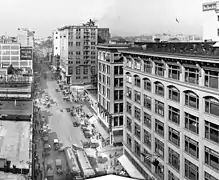 1917, west along 7th from Broadway
1917, west along 7th from Broadway
Landmarks
In order west to east. Source: Los Angeles Conservancy.[2]
Harbor Freeway to Figueroa
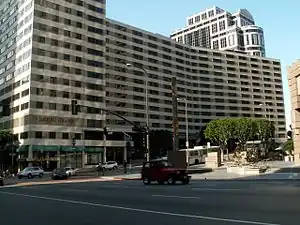
- Wilshire Grand Center, north side, tallest building in the Western United States. Located on the site of the original Wilshire Grand Hotel, opened in 1952 as the Hotel Statler. In 1954, renamed the Statler Hilton. In 1968, renovated and renamed the Los Angeles Hilton, and later the Los Angeles Hilton and Towers. Renovated again in 1963.
- FIGat7th, shopping center, originally called Seventh Market Place, housing both a Bullock's and May Co. branch in the 1980s-1990s
Figueroa to Flower
- Barker Brothers Building (818 Building) 818 W. Seventh Street, Curlett and Beelman (1926), Los Angeles Historic-Cultural Monument #356, Renaissance Revival, home of Barker Bros. furniture and homewares department store. Now offices.
- Home Savings of America Tower (Figueroa Tower), 831 W. Seventh Street, Albert C. Martin and Associates (1989).
- Fine Arts Building, 811 W. Seventh Street, Walker and Eisen (1926), Los Angeles Historic-Cultural Monument #125
- 7th Street/Metro Center light rail (A and E lines) and subway (B and D lines) station at 7th & Flower
Flower to Hope
- Roosevelt Building (The Roosevelt), 727 W. Seventh Street, Curlett and Beelman (1927), Los Angeles Historic-Cultural Monument #355/ National Register of Historic Places: Renaissance Revival building, purported to be the largest office building in Southern California when it opened. Curlett and Beelman designed six buildings on Seventh Street. Converted in 2008 to 222 residential units. Spectacular original restored mosaic marble floors in the lobby.
- The Bloc Los Angeles, originally built in 1973 called the Broadway Plaza, housing The Broadway department store after it moved from Broadway and 4th streets, now a Macy's
Hope to Grand
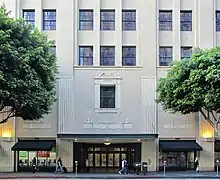
- J. W. Robinson's Building, 600 W. Seventh Street, Noonan and Richards (1915), Edgar Mayberry with Allison and Allison (1934 remodel), Los Angeles. The first major department store to move to Seventh Street from Broadway. Almost nine acres of floor space on seven floors. Robinson’s was immediately successful and spurred the further development of 7th Street as an upscale shopping district. In 1934, a major remodel gave the store its current Moderne façade, replacing the original Beaux Arts design.
- Union Oil Building, 617 W. Seventh Street, Curlett and Beelman (1923)
- Broadway Plaza (later Macy’s Plaza, now The Bloc), 700 W. Seventh Street, Charles Luckman Associates (1973): hotel, offices and shopping center originally with a Broadway department store branch replacing its downtown flagship on Broadway (the street)
Grand to Olive
- Brockman Building, 530 W. Seventh Street, Barnett, Haynes and Barnett (1912), National Register of Historic Places
- Quinby Building, 529 W. Seventh Street, Meyer and Holler (1926)
- Bronson Building (The Collection), 527 W. Seventh Street, Austin and Pennell (1913). Originally the Brack Shops, independent shops grouped together as a sort of department store.
- Brock and Company Building (Mas Malo/ Seven Grand), 515 W. Seventh Street, Dodd and Richards (1922), Los Angeles Historic-Cultural Monument #358
- Bank of Italy (Giannini Place), 505 W. Seventh Street, Morgan, Walls and Morgan (1922), Los Angeles Historic-Cultural Monument #354
- Coulter Dry Goods Company (later Myer Siegel, Dohrmann's, now The Mandel), 500 W. Seventh Street, Dodd and Richards (1917)
Olive to Hill
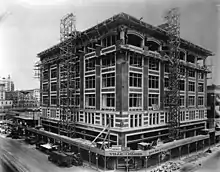
- Los Angeles Athletic Club, 431 W. Seventh Street, Parkinson and Bergstrom (1912), Los Angeles Historic-Cultural Monument
- Ville de Paris (department store), now L.A. Jewelry Mart, 420 W. Seventh Street, Dodd and Richards (1917)
- Dunn-Williams Building (Spreckels Building), fronting 7th and Hill, Samuel Heiman (1922), Los Angeles Historic- Cultural Monument #984
- Huntsberger-Mennell Building (International Jewelry Mart), 412 W. Seventh Street, Dodd and Richards (1917)
- Warner Brothers Theatre (a.k.a. Pantages Theatre, now "Jewelry Theater Center") 401 W. Seventh Street, B. Marcus Priteca (1920)
- Foreman & Clark Building (Jewelry Design Center), 400 W. Seventh Street, Curlett and Beelman (1928), Gothic Revival-style structure
- Sun Drug Building (later Great Western Savings, now Great Western Jewelry Plaza) 700 S. Hill Street (corner 7th), Curlett and Beelman (1922)
7th & Broadway
- Loew's State Theatre, 300 W. Seventh Street (SW corner of Broadway), Weeks and Day (1921), Los Angeles Historic-Cultural Monument #522/ National Register of Historic Places (Broadway Historic Theatre and Commercial District)
- Bullock’s Building (St. Vincent Jewelry Center), 319 W. Seventh Street (NW corner of Broadway), Parkinson and Bergstrom (1906), National Register of Historic Places, Broadway Historic Theatre and Commercial District
- St. Vincent's Court, small alley running through the center of the former Bullock's complex, built in the 1860s as the main entrance to St. Vincent’s College (now Loyola Marymount University) which then occupied the site. In 1956, a city boosters remodeled it as a faux European village square.
- Western Terminus of Route 66, Seventh Street at Broadway
Broadway to Spring
- Haas Building, 219 W. Seventh Street, Morgan, Walls and Morgan (1915), offices, 12 stories, Beaux Arts with terra cotta ornamentation, metal skin added in the 1970s. Now apartments.
- A.G. Bartlett Building a.k.a. Union Oil Building, The Bartlett, 215 W. Seventh Street, Parkinson and Bergstrom (1911), National Register of Historic Places (Spring Street Financial District), Beaux Arts, offices.
- I. N. Van Nuys Building (Van Nuys Apartments, 210 W. Seventh Street, Morgan, Walls and Morgan (1911), Los Angeles Historic-Cultural Monument #898/ National Register of Historic Places (Spring Street Financial District), since 1982 apartments, Beaux Arts.
Spring to Main
- Hellman Commercial Trust and Savings Bank, 650 S. Spring Street (corner of 7th), Schultze and Weaver (1925) National Register of Historic Places (Spring Street Financial District), Spanish Revival style. Since 2009, apartments. Former banking lobby serves as event space and filming location.
- Financial Center Building, 140 W. Seventh Street, Norton and Wallis, (1924), National Register of Historic Places (Spring Street Financial District)
7th & Main
- Los Angeles Board of Trade Building / California Stock Exchange (SW corner 7th/Main), 111 W. Seventh Street, Curlett and Beelman (1926), since 2009, apartments. Winged creatures adorn the building.
- Santee Court, 714, 716, 720, and 724 S. Los Angeles Street, Arthur W. Angel (1911), Los Angeles Historic-Cultural Monument #710. Block of industrial buildings converted (203) to mixed-use (residential, commercial, retail, and arts), facing a courtyard.
- Heywood Bros. & Wakefield / Dearden's Home Furnishings buildings: 700-710 S. Main Street, 1899, Architect unknown (ca. 1899); John Parkinson remodel (ca. 1902); 712-718 S. Main Street, R. B. Young (1901): Now closed, the last incarnation of Dearden's was especially patronized by Latino Angelenos familiar with its Spanish-language advertising, and comprised three buildings, all of which previously housed furniture stores: Heywood Bros. & Wakefield Company (circa 1899) on the corner, which become Overell’s in 1906; Hulse, Bradford & Company (1901) just to the south; and a third industrial structure to the rear.
Department stores on 7th Street and on Broadway
This is a table of the openings of department stores along the 7th Street and Broadway corridors:
| Opened | Left | Moved or closed? | Store | Floor area (gross) | Location | Architects | Current use |
|---|---|---|---|---|---|---|---|
| SPRING ST. BETWEEN TEMPLE AND SECOND | |||||||
| 1884 | 1898 | Moved to B'way | Coulter's | Hollenbeck Block, SW corner 2nd & Spring | Historic Broadway station | ||
| 1888 | 1908 | Moved to 8th/B'way | Hamburger's | Phillips Block, Franklin & Spring | Burgess J. Reeve | Site of City Hall | |
| 1889 | 1910 | Moved to B'way | Mullen & Bluett | 101–5 N. Spring | Empty lot | ||
| 1891 | 1900 | Moved to 3rd/B'way | Jacoby Bros. | 128–134(–138) N. Spring at Court | Site of City Hall | ||
| 1895 | ? | The Hub | Bullard Block, Spring at Court | Morgan & Walls | Site of City Hall | ||
| BROADWAY north of 4th St. | |||||||
| 1893 | 1898 | Moved to 317 B’way | Ville de Paris[3] (A. Fusenot Co.) |
Potomac Block, 221-3 S. Broadway | Block, Curlett & Eisen | added to Coulter's late 1907, demolished 1958, now a parking lot | |
| 1895 | 1915 | Moved to 7th St. | Boston Dry Goods (J.W. Robinson Co.) |
237–241 S. Broadway | Theodore Eisen and Sumner Hunt (architects of the Bradbury Building) |
Parking lot | |
| 1898 | 1905 | Moved to 200 block of B'way | Coulter's (1898–1905) | 317–325 S. Broadway through to 314–322 Hill Street[4] Homer Laughlin Building |
John B. Parkinson | became Ville de Paris Now Grand Central Market | |
| 1899[5] | 1935-6 | Moved to 605 B'way[6][7] | Jacoby Bros. | 60,000 sq ft (5,600 m2) | 331-333-335 S. Broadway | John B. Parkinson[8] | Was "Boston Store" in late 1930s.[9] Currently independent retail. 2 of 4 floors were removed. |
| 1899 | ? | Moved to 455 B'way then 617 B'way | I. Magnin/ Myer Siegel |
Irvine Byrne Block, 251 S. Broadway[10] |
Sumner Hunt | Wedding chapel | |
| 1905 | 1917 | Moved to 7th St. | Coulter's | 157,000 sq ft (14,600 m2)[11] | Potomac Block: 225-7-9 S. Broadway through to 224-6-8 S. Hill St. Late 1907 added 219-221-223 S. Broadway to store. | Block, Curlett & Eisen | demolished, site of parking lot |
| 1905 | 1917 | Moved to 7th St. | Ville de Paris | 96,000 sq ft (8,900 m2) | 317–325 S. Broadway through to 314–322 Hill Street[4] Homer Laughlin Building |
John B. Parkinson | Grand Central Market |
| 1905 | 1917 | Moved to 7th St. | J. J. Haggarty Co. “New York Store’ | 337–9 S. Broadway | Independent retail. Only 2 stories remain. | ||
| 1909 | ? | ? | J. M. Hale (Hale’s) | 341-343-345 S. Broadway[12] | retail, top floors were removed | ||
| BROADWAY south of 4th St. | |||||||
| 1896 | 1973 | Moved to B'way Plaza | The Broadway Dept. Store[13] | 1924, 577,000 sq ft (53,600 m2)[14] | SW corner 4th & Broadway, later through to Hill | Junipero Serra State Office Building | |
| 1904 | ? | ? | Silverwoods | 1920: 115,420 sq ft (10,723 m2)[15] | 556 S. Broadway (NE corner of 6th) | Broadway Jewelry Mart | |
| 1905 | ? | Closed | Fifth Street Store (Steele, Faris, & Walker Co.) Later called Walker's |
1917: 278,640 sq ft (25,887 m2)[16] | SW corner 5th & Broadway | Replaced existing store with new building in 1917[16] Building later housed Ohrbach's | |
| 1906 | 1986 | Moved to FIGat7th | Hamburger's After 1925: May Company |
1906: 482,475 sq ft (44,823.4 m2)[17][18] 1930, >1,000,000 sq ft (93,000 m2)[19] |
SW corner 8th & Broadway by 1930, entire block 8th/9th/Broadway/Hill |
Under renovation to become tech campus | |
| 1907 | 1983 | Closed, opened 1986 at FIGat7th | Bullock's | 1907: 350,000 sq ft (33,000 m2) 1934: 806,000 sq ft (74,900 m2)[20] |
NW corner 7th & Broadway by 1934, most of the block 6th/7th/Broadway/Hill |
Parkinson & Bergstrom | St. Vincents Jewelry Mart |
| 1907 | 1908 | Central Department Store[21] | 85,000 sq ft (7,900 m2), [22] | 609–619 S. Broadway | Samuel Tilden Norton | Demolished, now site of Los Angeles Theatre | |
| 1910 | 1960s | Mullen & Bluett | 610 S. Broadway (Walter P. Story Bldg.)[23] |
Morgan, Walls & Clements | Mixed-use | ||
| 1917 | Blackstone's | 118,800 sq ft (11,040 m2)[24] | 901 S. Broadway (SE corner 9th) | John Parkinson | Building became The Famous, now residential, retail | ||
| 1924 | 1972[25] | Abandoned Downtown L.A. | Desmond's | 85,000 sq ft (7,900 m2)[26] | 616 S. Broadway | A. C. Martin[27] | Renovated 2019 as office space, a restaurant and a rooftop bar.[26] |
| 1930 | 1957[28] | Eastern Columbia | 1930: 275,650 sq ft (25,609 m2)[29] (expanded through to Hill St. in 1950)[30] | 849 S. Broadway through to Hill | Claud Beelman | luxury condos | |
| 1936[7] | 1938[31] | Company liquidated | Jacoby Bros. | 605 S. Broadway[7] | became a branch of Zukor's (1940),[32] now mixed-use | ||
| 1947 | 1980[33] | Abandoned Downtown L.A. | Harris & Frank 2nd downtown location | 644 S. Broadway (Joseph E. Carr Bldg.) |
Robert Brown Young[34] | ||
| SEVENTH STREET | |||||||
| 1915 | 1993 | Abandoned Downtown L.A. | J. W. Robinson's | 1915: 400,000 sq ft (37,000 m2)[35] 1923: 623,700 sq ft (57,940 m2)[36] |
7th, Hope & Grand | Noonan & Richards (1915), Edgar Mayberry/Allison & Allison (1934 remodel) | Mixed-use |
| 1917 | 1933 | B. H. Dyas liquidated | Ville de Paris, from 1919 B. H. Dyas | 420 W. 7th (SE corner Olive) | Dodd and Richards | L.A. Jewelry Mart | |
| 1917 | 1938 | Moved to Miracle Mile | Coulter's | 500 W. 7th (SW corner Olive) | Dodd and Richards | Mixed-use | |
| 1917 | 1963[37] | Abandoned Downtown L.A. | Haggarty's | Brockman Building, 7th & Grand[38][39][40][41] |
George D. Barnett (of Barnett, Haynes & Barnett) |
Apartments | |
| 1926 | 1984[42] | Barker Bros. | Abandoned Downtown L.A. | 23 acres (1,000,000 sq ft; 93,000 m2)[43] | 818 W. 7th (Flower to Figueroa) | Curlett and Beelman | Offices |
| 1973 | open* | The Broadway | 250,000 sq ft (23,000 m2)[44] | Broadway Plaza 750 W. 7th (Hope to Flower) | Charles Luckman | Macy's | |
| 1986 | 1996 | Became duplicate Macy's, closed | Bullock's | Seventh Market Place now FIGat7th | Jon Jerde[45] | Gold's Gym (level M1), Target (M2), Zara (M3) | |
| 1986 | 2009a | Became duplicate Macy's, closed | May Company | Nordstrom Rack (level M1), Target (M2), H&M (M3) | |||
aas Macy's
Flower Street shopping district
For a time in the 1920s, Flower Street one block north and south of 7th, was an upscale shopping district. It began with the establishment of Chappell's at 645 S. Flower, which moved there from 7th Street in 1921 into a two-story, Spanish-style building, which exuded intimacy and tranquility compared to busy 7th Street or Broadway. It was innovative in offering parking in the rear.[46]
Barker Brothers opened their huge furniture emporium at 7th and Flower in 1926, two blocks west of J. W. Robinson's, which was already considered far west of the main Broadway shopping district. Myer Siegel followed a half block south, on Flower, that same year, as did Parmelee-Dohrmann, a large purveyor of china, crystal and silver. Other stores were Ashley & Evers, Ranschoff's, and Wetherby-Kayser shoes.
By 1931 Flower's heyday had petered out due to the depression, the opening of Bullock's Wilshire (1929)[47] and I. Magnin (1939)[48] much further west on Wilshire Blvd., as Myer Siegel's 1934 move to 7th Street.
References
- Google Maps
- Strolling along Seventh Street (PDF). Los Angeles Conservancy. 2010.
- "Ville de Paris 1901". Calisphere, University of California Library. Archived from the original on 9 September 2018. Retrieved 9 Sep 2018.
- "Ad for Ville de Paris". Los Angeles Herald. August 15, 1907.
- "Los Angeles Herald 22 August 1899 — California Digital Newspaper Collection". cdnc.ucr.edu.
- "Advertisement for Jacoby Bros./May Co". Los Angeles Times. May 19, 1935.
- "Pioneers' Modern Home: Jacoby Bros.Will Open New Store Soon". Los Angeles Times. January 31, 1936. p. 11.
- "Will Go Up Rapidly: Work on the Jacoby Building Was Begun Today: Most of the Material for the Big Business Structure Is Already on the Ground". Los Angeles Evening Post-Record. September 1, 1899. p. 1.
Architect John Parkinson
- "Boston Store Los Angeles 1939 - 331 S. Broadway (old Jacoby Bros.) and 4755 Whittier Blvd". The Los Angeles Times. 1939-11-06. p. 10. Retrieved 2020-12-06.
- "We move Monday to 251 South Broadway", I. Magnin advertisement in the Los Angeles Times, 31 Dec 1898, p.4
- "Great Store for Coulter". Los Angeles Times. August 2, 1904. p. 13.
- "Moving to Broadway: J. M. Hale Co. Go to Petticoat Lane". Los Angeles Evening Express. January 23, 1909. p. 4.
- "Los Angeles Herald 4 August 1895 — California Digital Newspaper Collection". cdnc.ucr.edu. Retrieved 2020-12-06.
- "Framework is now finished: Construction Started Late Last Fall: Additional Will Be Completed During July: Department Store Growth Is Consistent". Los Angeles Times. March 23, 1924. p. 91. Retrieved May 26, 2020.
- "Magnificent Pile That Now Graces Broadway Corner". Los Angeles Times. August 31, 1920. p. 9.
- "Broadway Buildings: To Cost Million". Los Angeles Times. April 22, 1917. p. part V p. 13.
Eight stories…plus basement and sub-basement…172 feet on Broadway by 162 feet on Fifth
- "Great Store's First Drill: Hamburger Army Through Paces for Opening; Get Familiar With "Lay" of New Establishment; Many Delights for Shoppers Are in Prospect". Los Angeles Times. July 26, 1908. p. V13. Alternate Link via ProQuest.
- "Hamburger's Big Store Celebrates: Thirty-Fifth Anniversary Sale To Mark Event; Started in Small Room on Main Street, Now Occupies Building with Thirteen Acres of Floor Space---History of the Great Emporium's Growth and Success". Los Angeles Times. October 29, 1916. p. III_A15. Alternate Link(subscription required) via ProQuest.
- "Advertisement for May Company". Los Angeles Times. March 25, 1930. p. 10.
- "Bullock's Department Store #1, Downtown, Los Angeles, CA (1906-1907)", PCAD
- "New Department Store Opens Doors to Public". Los Angeles Herald. March 26, 1907. p. 4.
- "New Department Store Opens Doors to Public". Los Angeles Herald. March 26, 1907. p. 4.
- "Walter P. Story Building". Los Angeles Conservancy. Retrieved August 9, 2020.
- "Material Progress: Millions Going into Broadway Buildings: New Blackstones". Los Angeles Times. April 22, 1917.
90 feet of frontage on Broadway and 165 feet on 9th Street…with 6 stories plus two basement levels
- "Ad for Desmond's Downtown LA Removal Sale". Los Angeles Times. February 10, 1972. p. 7.
- Vincent, Roger. "Historic home of clothier Desmond's is ready for its comeback on Broadway". latimes.com. Retrieved on 16 April 2019.
- Gray, Olive (September 16, 1924). "New Desmond Store Opened". Los Angeles Times.
- "Eastern-Columbia closes down 1957". The Los Angeles Times. 1957-02-03. p. 26. Retrieved 2020-12-06.
- "Concern Occupies New Home Tomorrow". Los Angeles Times. September 11, 1930. p. 8.
- "Eastern-Columbia expansion 1950". The Los Angeles Times. 1950-06-18. p. 26. Retrieved 2020-12-06.
- "Advertisement for liquidation of Jacoby Bros". Los Angeles Times. September 30, 1938. p. 45.
- "Downtown Broadway Store Leased in $1,000,000 Deal: Business Prepares to Expend $150,000 in Converting Property to Its Uses". Los Angeles Times. February 11, 1940. p. 63.
- "Harris & Frank advertisement". Los Angeles Times. January 17, 1980. Retrieved 7 May 2019.
- "Los Angeles Union Station Run-through Tracks Project", p. RA6-PP8
- "24 May 1914, 79 - The Los Angeles Times at Newspapers.com". Newspapers.com. Retrieved 2020-12-06.
- "11 Jan 1923, 27 - The Los Angeles Times at Newspapers.com". Newspapers.com. Retrieved 2020-12-06.
- "Haggarty's advertisement". June 23, 1963. p. 59.
- "J.J. Haggarty Growth Laid to Enterprise". Los Angeles Times. 10 November 1940. p. 67 (Part IV Society, p.9).
- Auerbach, Alexander (27 May 1970). "J.J. Haggarty Dress Chain Forced Out of Business by Debt". Los Angeles Times. p. 56 (part III Business & Finance, p.1). Retrieved 23 April 2019.
- "New York Store's Life Dream Comes True: J. J. Haggarty Ready to Open New Emporium at Seventh and Grand Tomorrow". Los Angeles Evening Express. September 19, 1917.
- "The "New York" to Start Building". Los Angeles Times. November 19, 1916. p. 27.
- "Ad for Barker Bros". Los Angeles Times. September 24, 1984. p. 6.
- Whitaker, Alma (July 13, 1931). "Furniture Has Its Romance: Fascinating Tale Found in Barker Brothers: Enormous Business Started by Outraged Man: Fourth Generation Working at Present Time". Los Angeles Times. p. 23. Retrieved 19 May 2019.
- "Broadway Plaza", Pacific Coast Architecture Database
- "Grand Opening for Downtown Mall Scheduled : Bullock's, May Co. Anchor Stores in Seventh Market Place". Los Angeles Times. 1986-04-06. Retrieved 2020-12-06.
- Longstreth, Richard (1997). City Center to Regional Mall: Architecture, the Automobile, and Retailing in Los Angeles, 1920–1950. MIT Press. pp. 41–43. ISBN 0262122006.
- "Designated Historic-Cultural Monuments". Archived from the original on 2011-10-02. Retrieved 2011-10-03.
- "Wilshire Galleria", Los Angeles Conservancy
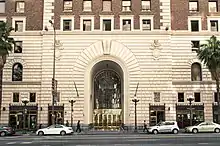
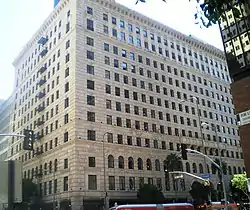

.jpg.webp)
.jpg.webp)
